Asus ZenFone 2 Review
Asus’ 5.5-inch smartphone comes with an Intel processor and 4GB of RAM. Will its PC-like approach to creating smartphones leave you in a Zen-like state?
Why you can trust Tom's Hardware
CPU And System Performance
In this section, we evaluate system-level performance by running a series of synthetic and real-world workloads, along with some browser-based Web tests. There are several facets to overall device performance, including single- and multi-threaded CPU performance, memory and storage speed, and GPU rendering, all of which will be probed by our suite of benchmarks. If you're interested in learning more about how these benchmarks work, what versions we use, or our testing methodology, please read our article about how we test mobile device system performance.
| Products | CPU | GPU | RAM |
|---|---|---|---|
| Asus ZenFone 2 | Intel Atom Z3580 (4x @ 2.33GHz) | PowerVR G6430 @ 533MHz | 4GB |
| Apple iPhone 6 Plus | Apple Cyclone+ (2x @ 1.4GHz) | PowerVR GX6450 | 1GB |
| Motorola Moto G (3rd gen) | Snapdragon 410ARM Cortex-A53 (4x @ 1.36GHz) | Adreno 306 @ 400MHz | 2GB |
| Sony Xperia M4 Aqua | Snapdragon 615ARM Cortex-A53 (4x @ 1.5GHz + 4x @ 1.0GHz) | Adreno 405 @ 550MHz | 2GB |
| LG G4 | Snapdragon 808ARM Cortex-A57 (2x @ 1.82GHz) + ARM Cortex-A53 (4x @ 1.44GHz) | Adreno 418 @ 600MHz | 3GB |
| Samsung Galaxy S6 | Exynos 7420ARM Cortex-A57 (4x @ 2.1GHz) + ARM Cortex-A53 (4x @ 1.5GHz) | ARM Mali-T760MP8 @ 772MHz | 3GB |
The ZenFone 2 we’re testing comes with an Intel Atom Z3580 SoC and 4GB RAM. The 64-bit, quad-core CPU idles at 500MHz and ramps up to a maximum of 2.33GHz. Because this is the first time we’ve tested the Atom in a phone, we’re going to compare it to several different SoCs (shown in the table above) to determine where it falls in terms of performance.
Looking first at the System test, which evaluates single- and multi-threaded integer and floating-point performance, the ZenFone 2 scores 1.72x better than the Moto G (3rd gen). With the same core count as the Snapdragon 410, the 1.71x difference in CPU clock frequency implies that an Atom core performs about the same as an A53 core clock for clock. The ZenFone 2’s Atom SoC scores 34% lower than the A8 in the iPhone 6 Plus and 43% lower than Samsung’s Exynos 7420, its eight CPU cores adding to its advantage.
The ZenFone 2’s PowerVR G6430 GPU is bracketed by the Adreno 405 and the Adreno 418 in the Graphics test. It’s no surprise to see the iPhone 6 Plus perform better either, since it’s using a newer, more powerful configuration of the PowerVR GPU.

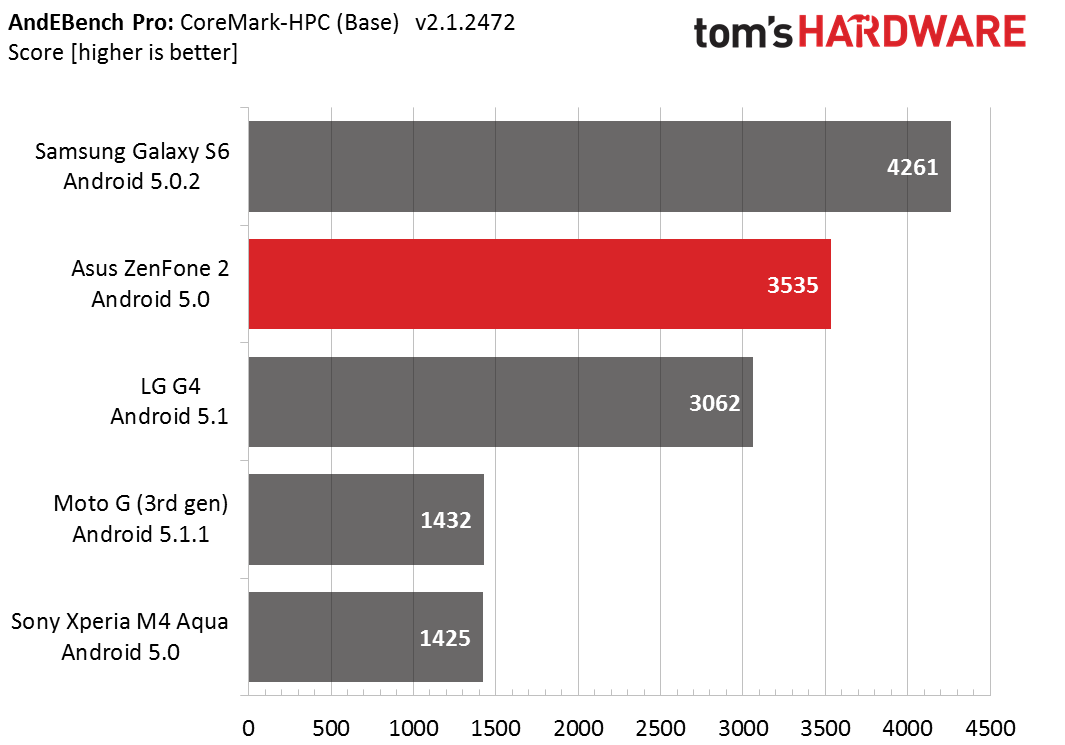
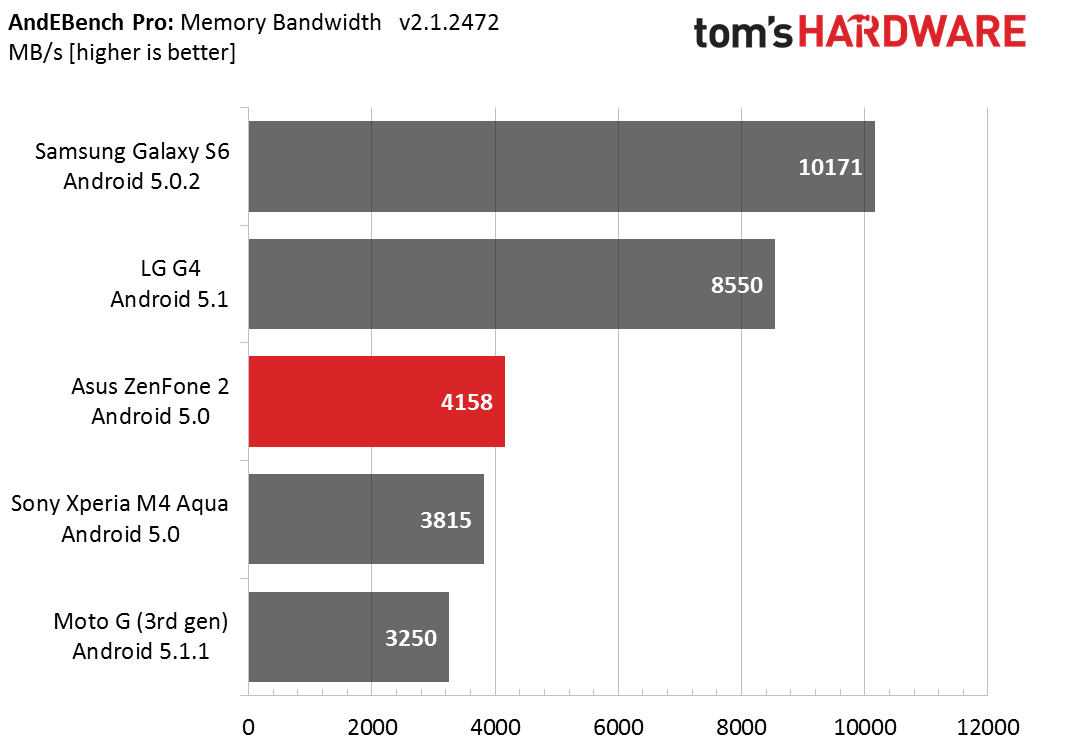

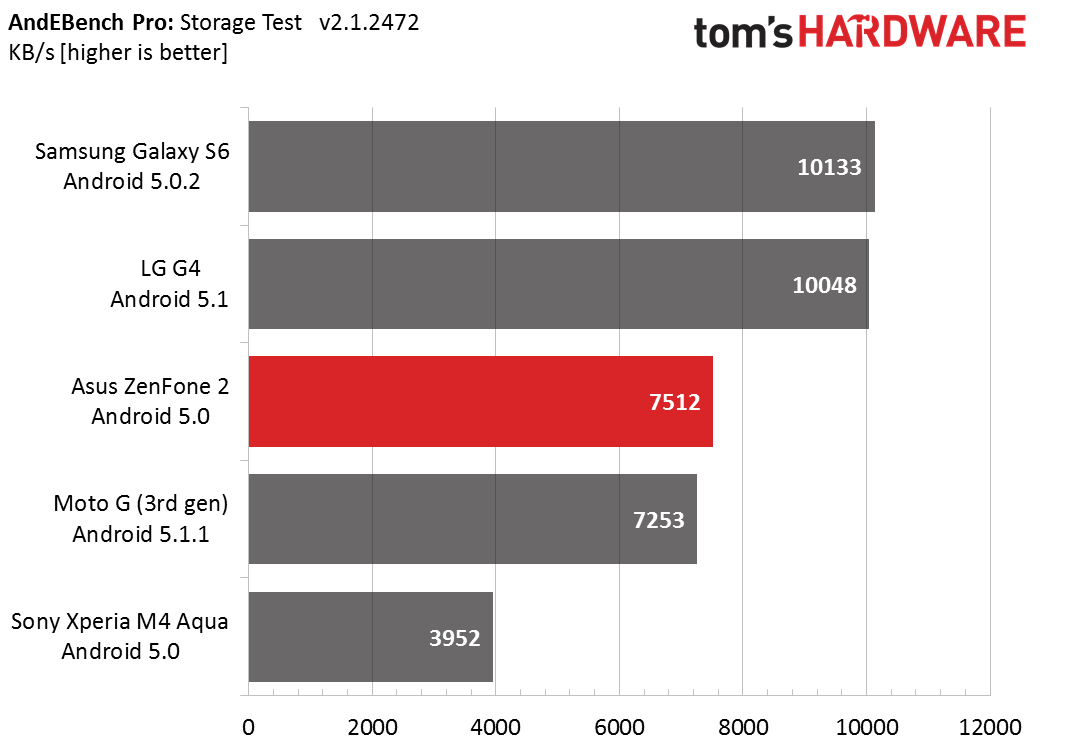
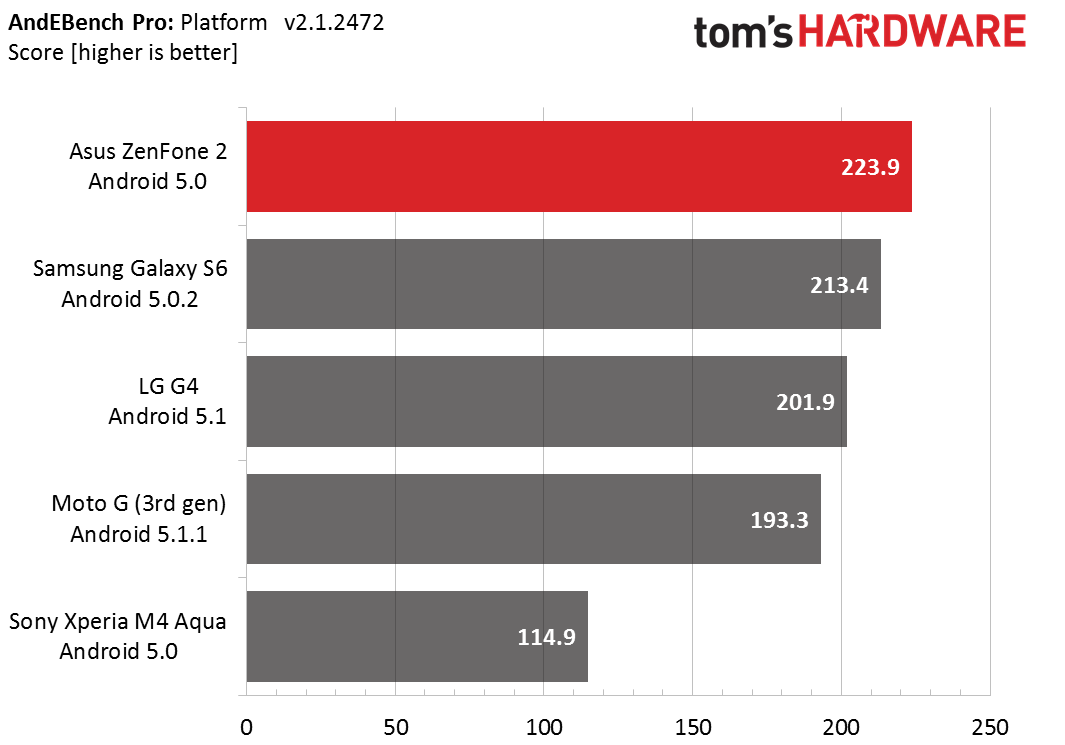
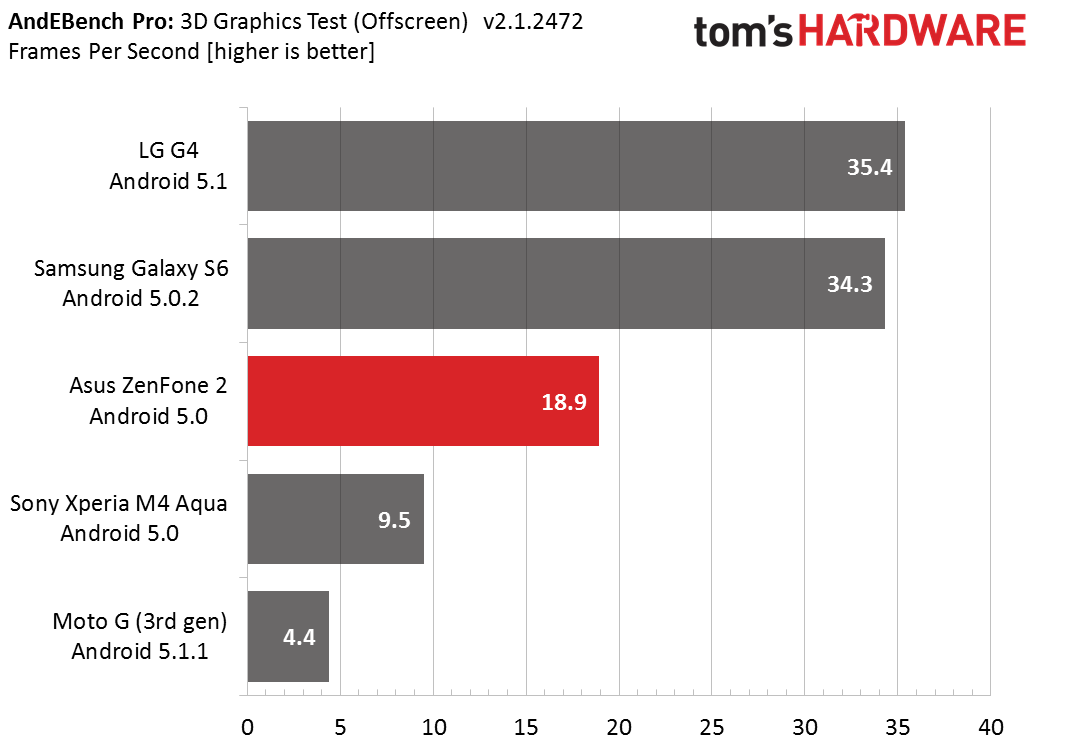
In the AndEBench Pro suite, the ZenFone 2 scores only 10% lower overall than the LG G4 and 24% lower than the Galaxy S6 (currently the fastest Android phone), giving the ZenFone 2 a superior performance-per-dollar ratio.
Digging a bit deeper shows the Atom SoC in the ZenFone 2 outperforming the Snapdragon 410 in the Moto G (3rd gen) by ~2.5x in the CPU-centric CoreMark-Pro test. This is an even larger margin than we saw in Basemark OS II System, with performance scaling greater than the clock frequency difference. The ZenFone 2 even outperforms the G4 in this test by 15%. This is because the G4 only utilizes its two A57 cores (the A53 cores remain mostly idle) versus the ZenFone 2’s four CPU cores.
The Atom SoC uses LPDDR3 RAM at 800MHz, limiting maximum bandwidth to 12.8 GB/s. It’s no surprise then to see the ZenFone 2 perform similarly to the Moto G (3rd gen) and Xperia M4 Aqua in the Memory Bandwidth test. The LPDDR4-1600MHz RAM in the Galaxy S6 far outpaces it, but so does the LPDDR3-933MHz RAM (14.9 GB/s) in the G4, far more than we’d expect based on theoretical bandwidth alone. We’ve seen similar behavior from the Snapdragon 810, and we believe this is because Qualcomm’s latest memory controllers are optimized for serial access. Further evidence for this hypothesis comes from the Memory Latency test, which uses a random access memory pattern, where the G4 falls to the bottom of the chart. With its stronger performance in the Memory Latency test, the ZenFone 2’s memory subsystem should perform well during normal application use but struggle a bit when reading/writing large blocks of serial data, like photos and videos.
Get Tom's Hardware's best news and in-depth reviews, straight to your inbox.
The Platform test, which simulates a real-world workload, shows that the ZenFone 2 does indeed perform quite well in a normal use case. It even outperforms the Galaxy S6!
| AndEBench Pro Storage Test | |||||||||
|---|---|---|---|---|---|---|---|---|---|
| Row 0 - Cell 0 | 512BSW | 512BRW | 4KBSR | 4KBSW | 4KBRR | 4KBRW | 16KBRR | 256KBSR | 256KBRR |
| ZenFone 2 | 230 | 702 | 22417 | 1706 | 22899 | 5550 | 53749 | 113614 | 104668 |
| Galaxy Note 4 | 449 | 1025 | 20877 | 3340 | 20425 | 7992 | 56653 | 125891 | 127268 |
| ZenFone 2 % Diff | -48.8% | -31.5% | 7.4% | -48.9% | 12.1% | -30.6% | -5.1% | -9.8% | -17.8% |
| First letter: S=sequential, R=randomSecond letter: R=read, W=write | Values in KB/s - Higher is betterFile Size: 5, #Folders: 3, #Files/Folder: 1 |
The ZenFone 2’s internal storage performance is typical for a mid-range phone. Read performance is pretty decent, about on par with the Galaxy Note 4. This is important because read performance impacts the user experience more than write performance; it limits how quickly apps can launch. From these performance numbers, we can see that the ZenFone 2 launches apps nearly as quickly as the more expensive Note 4.


Looking at the Geekbench single-core results confirms what we saw in the Basemark OS II System test. Namely, a Silvermont CPU core is roughly equivalent to an A53 core at the same clock frequency. The ZenFone 2, which has a 1.71x advantage in CPU clock frequency, outperforms the A53 core in the Moto G (3rd gen) by a margin of 1.64x in the integer test and 1.93x in the floating point test, working out to 1.73x overall.
Having twice as many cores clocked at a higher frequency gives the ZenFone 2 similar performance to the iPhone 6 Plus in the multi-core test.
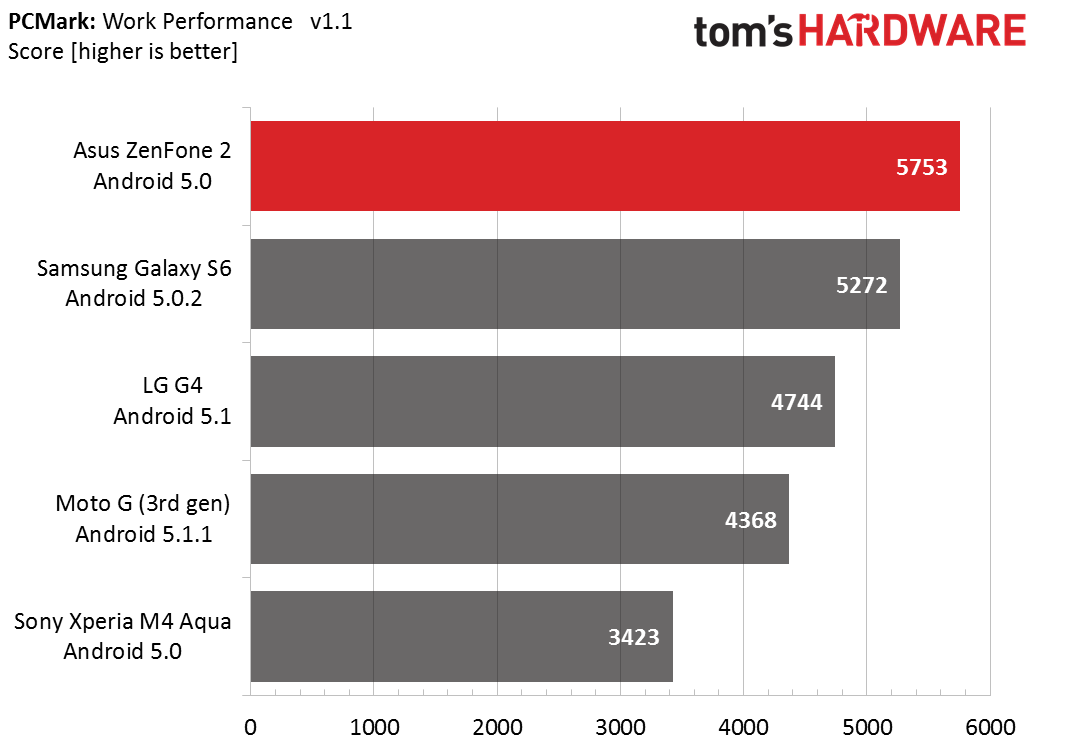

Theoretical performance is good for bragging rights, but how a phone performs when running real-world scenarios is what truly matters. We already saw the ZenFone 2 claim victory in the AndEBench Pro Platform test, and now we see it rise to the top once again in PCMark, beating out the Galaxy S6 by a slim 9% margin.
The Galaxy S6 falls behind mainly due to its low Video Playback score, a test the ZenFone 2 has no trouble with. The Asus phone also does well in the Web Browsing test, outpacing the G4 but trailing the S6 by 16%.
Where the ZenFone 2 really shines is the Photo Editing test, performing 52% better than the second place S6. Most of the image processing during this test is supposed to occur on the GPU using the android.media.effect API. Monitoring the CPU and GPU core frequencies shows this is true for the ZenFone 2. Both the S6 and G4, however, appear to be using their CPUs instead, resulting in lower performance. It’s possible that only the ZenFone 2’s PowerVR graphics driver supports this feature.
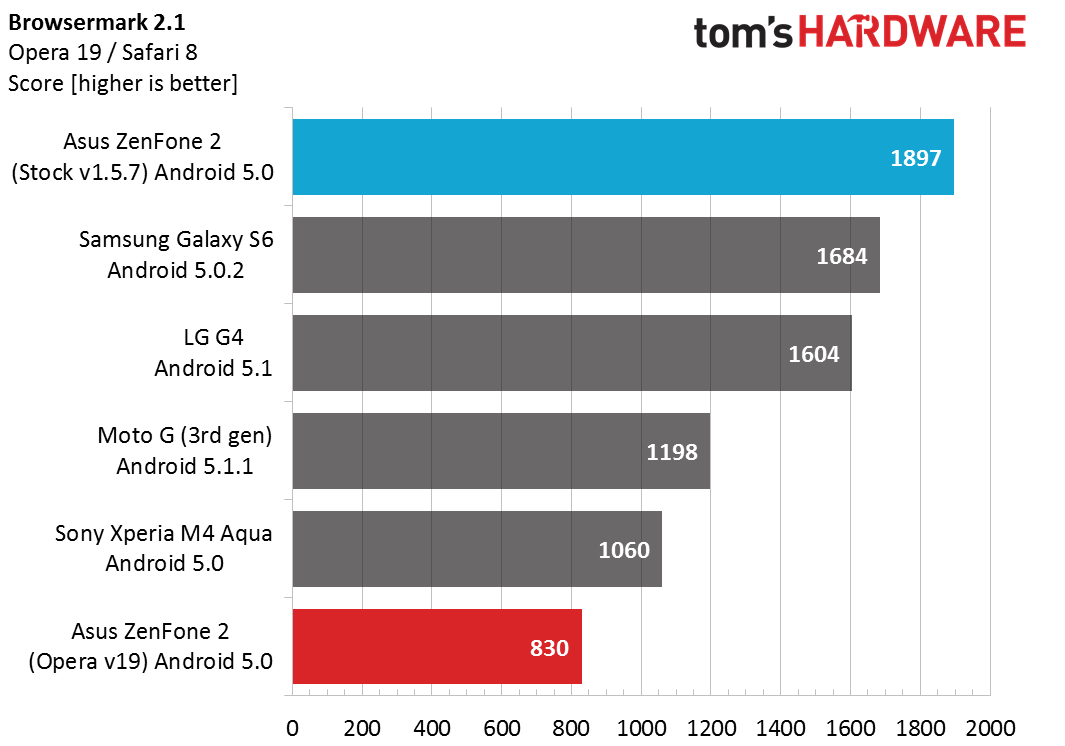


We use a static version of the Opera browser for Android testing to keep results comparable and avoid benchmark cheating. Unfortunately, the older version we’re using clearly does not like the x86 architecture. We’ve already seen that the Atom SoC in the ZenFone 2 performs competitively, so the abnormally low Opera browser results should be ignored.
With the Opera results compromised, we reran the tests using the stock browser app (JSBench did not work in this browser). These results show that the ZenFone 2 is more than capable of running JavaScript code. Note, however, that these results are not comparable to the other phones using Opera, since the stock browser app is newer and has a faster JavaScript engine.
So, what conclusions can we draw from our testing? The synthetic tests show that Intel’s Silvermont CPU core is roughly equivalent to an ARM A53 core at the same clock frequency, with Silvermont holding a slight advantage in floating point performance. Running its CPU cores at a higher frequency gives the Atom Z3580 a performance advantage over A53 based SoCs such as the Snapdragon 410 and 615 as well as most MediaTek SoCs, however. While it’s a strong contender in the mid-range market, Atom still cannot match the theoretical performance of Apple’s A8 or A57 based SoCs like the Exynos 7420 at the high-end of the market.
Ultimately, theoretical CPU performance is only part of the user experience equation. Running more realistic, mixed workloads that stress the entire system is when the ZenFone 2 rises to the occasion. Its combination of decent CPU performance, reasonably quick NAND reads, and a memory controller optimized for random memory accesses makes it feel like you’re using a flagship device that costs several hundred dollars more.
-
wtfxxxgp I like the look. I love the price. Seems like a gem of a phone if good value is more important to you than the latest and greatest tech. I wonder if it'll be available here in South Africa...Reply -
MasterMace 2 things that ding the phone before it even started: locked battery, 1080p screen. The LG G4 and Galaxy S6 both have 1440p screens. The LG G4 has a removable battery.Reply -
edwd2 Reply2 things that ding the phone before it even started: locked battery, 1080p screen. The LG G4 and Galaxy S6 both have 1440p screens. The LG G4 has a removable battery.
Yeah, but the G4 and S6 also cost a whole lot more. Not to mention that the G4's A418 has trouble powering that 1440p res while the G6430 is just fine with a 1080p screen.
And what does LG have to offer in the $200 price range? The LG G-Stylo runs a crappy SD410 and 720p display. -
g-unit1111 I wish we'd embrace the concept of dual SIMs and unlocked phones more here in the States. This is a very nice phone for the price and more carriers should be able to use it, right now it seems like only AT&T and Verizon can use it, leaving T-Mobile and Sprint out of it.Reply -
PC98226 Great review. I was looking for your comments re: this device's ability to maintain wireless connectivity. I have been using the 4GB version of this phone for several months now. While I found it to have a VERY snappy speed, I experienced some quirks re: it connectivity. I would frequently have to check why the phone stalled trying to open up a web site only to realize that it had switched the connection from my WiFi to my wireless printer. This happened so frequently that it slowed me down re: productivity. I suspected there was some type of software glitch that needed to some attention. So, until that happens, I have returned to using my Moto X (2014). During your testing of this device, did you see or experience anything like the above?Reply -
MRCPU I own one of these, and I really like it. Asus has been very good about pushing fairly regular software updates, much faster than any carrier. For a time, it seemed like updates were hitting like clockwork about every 2 weeks.Reply
However, the one downside to this phone is the *massive* amount of bloat. The author touches on it a bit, but did not convey how much pure crap resides on this phone stock.
However, there are many fixes available to that problem. A quick google for debloating scripts will get you headed in the right direction.
My only other gripe is that mp3-based notification tones don't seem to consistently stop if you like touch the screen, or acknowledge the notification, you can't flip the phone over to silence it like on the Galaxy series. But these are minor nits.
I get a full day of usage out of my battery, the quickcharge is nice, and for 300 bucks, the extra features of the other phones aren't appealing enough.
I recommend this phone to anybody. -
PC98226 Reply16526515 said:"....However, the one downside to this phone is the *massive* amount of bloat. The author touches on it a bit, but did not convey how much pure crap resides on this phone stock."
Yes, I totally agree re: the massive amount of crapware pre-installed on this device. I tried to either uninstall or disable all that I could (nearly 33 apps in all) before I installed the apps I wanted to use. Now, these apps no longer auto-update so that is a help.
-
GoZFast I owned this phone from newegg since late May and I have to say that its the best phone I have ever had over LG, Samsung, iPhone, Blackberry etc The kernel is 64 bit but not the OS. Asus are working on a completely x86_64 Intel OS based on Android/Linux source code. Some apps are not x86 compatible yet but when they are, they run much more efficient than ARM. Its price of 299$ for the top 4Gb RAM model is too good for what it offers and if you even want more, you can join ZenTalk beta forum. With beta firmware, the phone is faster and battery lasts longer, never had an issue with beta firmware so far. This is also the coldest phone I have had, much colder than G3 and G2. Anything over 1080p in a 5'' device is pointless and will just consume more battery, create more heat and put a high load on the GPU. What also amazed me is that you can run 128Gb SDcards EVEN if the specs says 64Gb (Lexar 633x) The 18W 9V2A charger is faster than Samsung's 9V1.67A adaptive charger. Here is my newegg review, basically, the Atom CPU beats the SD810 and S6 in single threaded performance (Floating-point and Integer), it only loses in multithread (Hence, higher Antutu score) because its rivaling 8 cores so imaging doubling this in a future phone! I also doubt that playstore apps will take advantage of 8 cores like Anututu and hence, their higher score doesn't mean that 4 core or less apps will be faster. Intel can easily add more cores with 14nm but other are already 8 cores with 14nm and it will be very hard to increase performance with more than 8 cores. Intel Core M with Intel GPU in tablets is 3.5W while the Atom is 2.2W. If Intel can find a way to integrate it into smartphone, it will be a heck of a phone considering that it gets ~3000pts in PassMark similar to Intel Core i5-3317U or an AMD A10-5757M.Reply
Pros: Intel 64bit 3D 22nm Quad 2.33Ghz
4GB Ram, did I underscore its speed?
This outperforms all current cellphones (yes, faster than snapdragon 810) and have lots of headroom for improvement on intel architecture with more instruction sets for programming. We will probably see this device quad boot; android:windows:linux:mac os x
Lots of potential.
9v 18w charger! Higher than 12w ipad lol
Cons: PowerVR G6430, same architecture as iphone 6+ but this intel extracts more gpu power vs dual-core 1.4ghz apple.
Wish it had intel graphics which is up to 4x more powerfull than Adreno 430, highest current mobile gpu. Intel graphics would also throw more compatibility and instruction sets into the table.
14nm and 3200mah maybe?
Camera could be better (4k?) but not a fan of photography, it does what it says.
Other Thoughts: For more battery life, put screen into reading mode and dim it as the default setting is very bright. Also, there is option to powersave in settings. You can also remove unnecessary apps, use system app remover for system apps (Not needed with Beta firmware) Getting better battery than my old g3.
p.s: With beta firmware, you can disable/uninstall any app you want, even system apps without root. Root will break OTA and live beta updates. Many of these apps are actually useful though. Also, I found that Nova launcher decreased RAM usage by 80Mb and its snappier (Doesn't need root) -
fyend Asus rivals Samsung with the amount of uninstallable crapware they preload on their phones. If you're planning to root, that's fine you can remove it all, but if not you're stuck with a lot of junk.Reply
